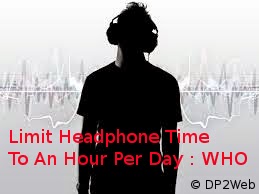Wrenching up the tunes today may prompt the failure to hear them tomorrow, concurring the World Health Organization. Young people have a tendency to turn the volume excessively high on their mobile music gadgets, and also visit noisy shows and clubs. Thus, more than 1.1 billion people ages 12-35 are at danger of listening to misfortune, the WHO said in a late proclamation.
A few studies have demonstrated that the quantity of young people with harmed hearing has expanded over the previous decade, likely on account of the uplifted utilization of iPods and cell phones to play loud music. In 1994, 3.5 percent of American teens experienced listening to misfortune, however that number rose to 5 percent by 2006. To battle this expand, the WHO prescribes listening to mobile gadgets for a most extreme of one hour per day, and the volume ought to stay around 60 percent.
The thought is to minimize perilous listening practices, which rely on upon two factors: to what extent you listen and how loud the sound is. The sound of a regular discussion is 60 decibels, which won't result in any listening to issues. In any case a sitting out of gear bulldozer is around 85 decibels, which can result in permanent harm after eight hours. Sounds like an applaud of thunder or even a nearby vuvuzela time in at 120 decibels, harming hearing after only nine seconds. Listening to misfortune from these loud, managed sounds can be prompt, or they develop after some time as the fragile structures in the internal ear get to be more harmed.
Be that as it may, headphones can be both great and terrible for our sound-related health, as per Kathleen Campbell, an educator at Southern Illinois University School of Medicine who spends significant time in audiology. Over-ear or clamor scratching off headphones are perfect, in light of the fact that they urge people to turn down the volume of the music they're playing. People have a tendency to incline toward their music to be relatively louder than any foundation commotion, however in the event that they can't hear that clamor, they're not as slanted to turn up the music's volume. Defective headphones, then again, make us more prone to turn up the volume, which can be awful news; headphones at greatest volume can debilitate hearing in only four minutes, and numerous young people don't even understand that those stunning impacts can be permanent.
To prevent listening to misfortune considerably further, WHO takes note of that headphone producers and government regulators ought to do their part to create listening gadgets that don't unavoidably affect listeners. Loud venues like shows or clubs ought to offer earplugs or calm spaces where benefactors can show their ears an a bit of mercy.
However meanwhile, WHO says its dependent upon listeners to deal with their listening ability. The sort of music you listen to isn't as imperative as its volume or span, Campbell says, "yet devotees of distinctive sorts of music have a tendency to have diverse volume inclination." Using commotion dropping headphones may help listeners oppose the allurement to turn it up.
A few studies have demonstrated that the quantity of young people with harmed hearing has expanded over the previous decade, likely on account of the uplifted utilization of iPods and cell phones to play loud music. In 1994, 3.5 percent of American teens experienced listening to misfortune, however that number rose to 5 percent by 2006. To battle this expand, the WHO prescribes listening to mobile gadgets for a most extreme of one hour per day, and the volume ought to stay around 60 percent.
The thought is to minimize perilous listening practices, which rely on upon two factors: to what extent you listen and how loud the sound is. The sound of a regular discussion is 60 decibels, which won't result in any listening to issues. In any case a sitting out of gear bulldozer is around 85 decibels, which can result in permanent harm after eight hours. Sounds like an applaud of thunder or even a nearby vuvuzela time in at 120 decibels, harming hearing after only nine seconds. Listening to misfortune from these loud, managed sounds can be prompt, or they develop after some time as the fragile structures in the internal ear get to be more harmed.
Be that as it may, headphones can be both great and terrible for our sound-related health, as per Kathleen Campbell, an educator at Southern Illinois University School of Medicine who spends significant time in audiology. Over-ear or clamor scratching off headphones are perfect, in light of the fact that they urge people to turn down the volume of the music they're playing. People have a tendency to incline toward their music to be relatively louder than any foundation commotion, however in the event that they can't hear that clamor, they're not as slanted to turn up the music's volume. Defective headphones, then again, make us more prone to turn up the volume, which can be awful news; headphones at greatest volume can debilitate hearing in only four minutes, and numerous young people don't even understand that those stunning impacts can be permanent.
To prevent listening to misfortune considerably further, WHO takes note of that headphone producers and government regulators ought to do their part to create listening gadgets that don't unavoidably affect listeners. Loud venues like shows or clubs ought to offer earplugs or calm spaces where benefactors can show their ears an a bit of mercy.
However meanwhile, WHO says its dependent upon listeners to deal with their listening ability. The sort of music you listen to isn't as imperative as its volume or span, Campbell says, "yet devotees of distinctive sorts of music have a tendency to have diverse volume inclination." Using commotion dropping headphones may help listeners oppose the allurement to turn it up.

No comments:
Post a Comment